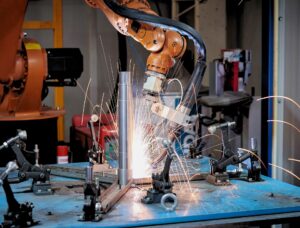Weld penetration is one of the most critical factors that determine the strength, durability, and overall quality of a welded joint. Whether you’re working with MIG welding, TIG welding, metal arc welding, or advanced processes like laser welding, understanding weld penetration ensures your welds are structurally sound and defect-free.
What Is Weld Penetration?
Weld penetration refers to how deeply the weld metal fuses into the base metals being joined. It’s the extent to which the weld melts and bonds beneath the surface, creating a strong joint.
- Shallow Penetration: The weld only partially fuses the base metals near the surface.
- Deep Penetration: The weld extends well into the base metal, ensuring full fusion and structural integrity.
Why Does Penetration Matter?
- Strength: Deep penetration ensures maximum fusion, resulting in stronger, more durable welds able to withstand mechanical stress.
- Weld Defect Prevention: Insufficient penetration can lead to lack of fusion, porosity, and cracks that compromise safety.
- Weld Quality Control: Achieving proper penetration is key for passing inspection tests, especially in critical industries like aerospace, oil & gas, and shipbuilding.
Shallow vs. Deep Penetration: What’s Right?
- Shallow Penetration:
Useful for thin metals where burn-through risk is high. Common in sheet metal fabrication or tack welding.
However, it may not meet strength requirements for load-bearing joints. - Deep Penetration:
Required for thick materials and critical structural welds. Ensures full penetration and fusion across the joint.
Usually achieved with higher heat input and correct technique.
How to Achieve Proper Weld Penetration
- Adjust Welding Parameters
- Increase amperage or voltage to add heat for deeper fusion.
- Use slower travel speeds to allow heat to penetrate.
- Choose appropriate electrode size and type.
Welding cameras help monitor these settings in real time for consistency.
- Optimize Joint Preparation
- Proper beveling and cleaning improve penetration.
- Correct joint fit-up ensures the arc can reach all areas.
- Use welding inspection techniques to verify joint prep.
- Use the Right Welding Process
- Processes like TIG welding provide precise heat control for penetration.
- Metal arc welding and MIG welding can achieve deep penetration with correct settings.
- Laser welding offers high penetration depth with minimal heat-affected zones.
- Maintain Proper Technique
- Keep a consistent arc length.
- Maintain correct electrode or torch angle.
- Use stringer beads over weaving on thicker materials to promote penetration.
Common Issues Related to Penetration
- Lack of Penetration:
Results in weak joints that may crack or fail under stress. Often caused by low heat input, high travel speed, or poor joint preparation. - Excessive Penetration (Burn-Through):
Occurs when too much heat melts through the base metal, causing holes or excessive spatter. Common in thin metals. - Uneven Penetration:
Leads to stress concentrations and possible weld failure. Often due to inconsistent technique or improper parameters.
How Welding Cameras Improve Penetration Control
Weld monitoring cameras provide real-time arc welding images that allow operators to:
- Visualize the weld pool and penetration depth live.
- Adjust heat input and travel speed on the fly.
- Detect early signs of penetration issues before defects form.
- Archive video for quality control and training.
Manufacturers like Mecaweld offer specialized weld monitoring systems designed for precise control of penetration in various welding processes.
Conclusion: Penetration Is the Backbone of Strong Welds
Understanding weld penetration is essential for producing high-quality, reliable welds. With the right parameters, preparation, and technology—like welding cameras—you can ensure your welds meet strength requirements and avoid costly rework.
Ready to take your weld penetration control to the next level? Contact Mecaweld to explore our advanced welding cameras and inspection solutions tailored to your industry.



